 |
||
|
||
| ||
This review sets off a series of articles on professional musical programs. Such reviews are meant for prepared readers who create music on computers themselves. Today we will speak about a software 32bit HALion sampler which is a VST instrument, or simply VSTi. VSTi is a software sound synthesizer which generates sound on the fly on a MIDI track and has a separate audio-out (or several outputs) in a sequencer for setting different effects. The VSTi in ASIO-oriented applications has its analog - the DXi technology in DirectX applications. Today musicians who widely use VST instruments go with the Cubase and Nuendo sequencers. The HALion sampler can be used in any of the two applications. The HALion supports samples of different formats, which makes it universal and convenient in operation. Thus, it supports PCM wav files up to 24/96, sample banks for VST instruments LM-4, LM-9 (with headings in txt), the drumloop format Propellerhead ReCycle (REX, REX2) and Steinberg sequencers' presets formats (fxp, fxb). The sampler can also read and convert such widespread and irreplaceable formats as GIG and AKAI. It's important that the HALion imports them correctly with all the information on samples provided. Moreover, for owners of collections of SoundFont banks it supports sf2 importing. From the practical standpoint I consider importing of GIG and AKAI samples the most important feature (no secret that exactly these formats contain highest-quality samples). The HALion is thus a normal VST instrument which can play GIG and AKAI samples. But what about the software Gigastudio sampler? First of all, the Gigastudio is inferior in the ease of use. For example, samples can be edited only in a separate program. Although a set of effects is not scanty, it's quite a problem to stick effects of the sequencer to each MIDI channel separately. But tastes differ. A bit later we will dwell upon conveniences of the HALion. Now let me attract you attention to the new niceties in the latest version of the HALion 1.11:
So, let's kick off with the edit option of the VSTi instrument: choose it and the main window of the HALion sampler will open. 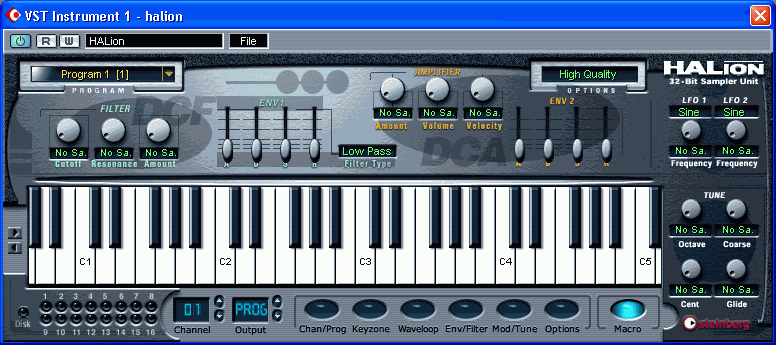 HALion sampler, Macro tab This is the main view of the sampler named Macro. It contains the main adjustable parameters of the samples loaded into the HALion. The sampler has nothing by default, and this screenshot and the windows of settings shows No Sample. The keyboard has 10.5 octaves. The keys can be adjusted in size. On the left under the window showing the sample you've loaded there are regulators for parameters of the filter and its envelope. The filter has 4 standard configurations. Slope of all the filters makes 12 dB per octave and for the low-frequency filter it is 24 dB per octave. To the right you can find controllers of the waveform and its envelope. In the right-hand corner below you can adjust a pitch of tone of the sample. All settings located in the Macro tab are common for a selected instrument. But quite often an instrument combines multiple samples which are to be adjusted separately. It's also possible here, but it will be spoken about later. The next tab is Chan/Prog. It deals with loaded samples of various instruments, shows MIDI channels and an output of the used sequencer they belong to. You can use up to 16 programs (instruments) simultaneously, but there are only 8 channels in the sequencer which can be assigned separately (they are shown in the drop-down menu). 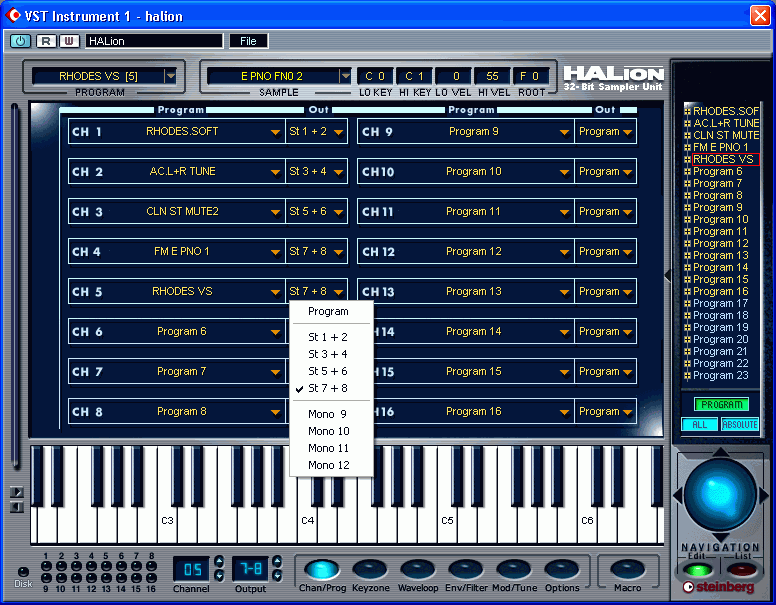 HALion sampler, Change/Program tab It means that the HALion has only 8 independent outputs you can use to hang the sequencer's effect on. Four of them are only mono. But if it's not enough you can use one more HALion. It will be set as HALion2, and the Cubase SX supports up to 32 VST instruments simultaneously (Cubase 5.1 offers 8 instruments). However, modern computers will hardly cope with more than three HALions. But it's not needed in real tasks. The next tab is Keyzone, one of the pictorial sample editors. Here you can see a contrabass opened. 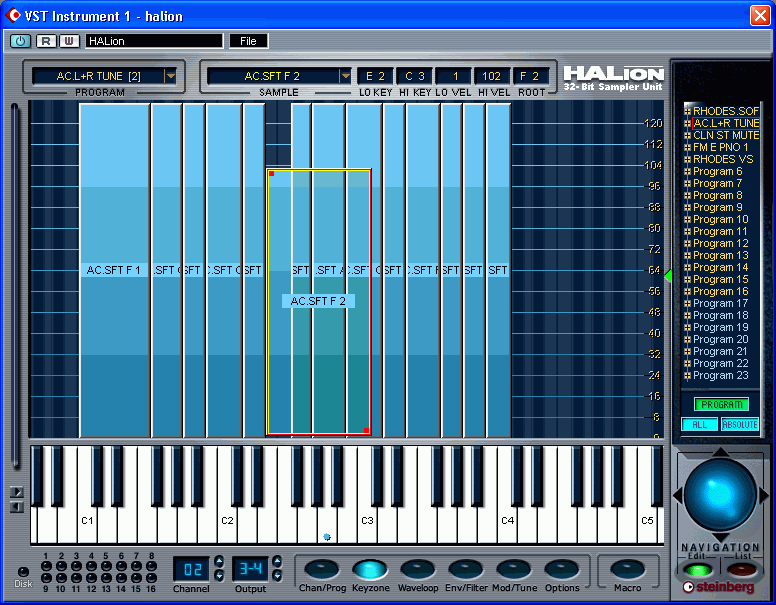 HALion sampler, Keyzone tab The instrument possesses several samples. It's very convenient to change parameters of any of them: from the Velocity level (vertical scale from 0 to 127) to adjustment of transitions from one sample to another when they overlap (fade, pitch). The Waveloope tab shows the same samples in different light, where you can also graphically edit a selected sample.  HALion sampler, Waveloop view The screenshot shows the same contrabass's sample. The editable parameters are standard: beginning and end of playback, fade in and fade out. The next tab is called Env/Filter. 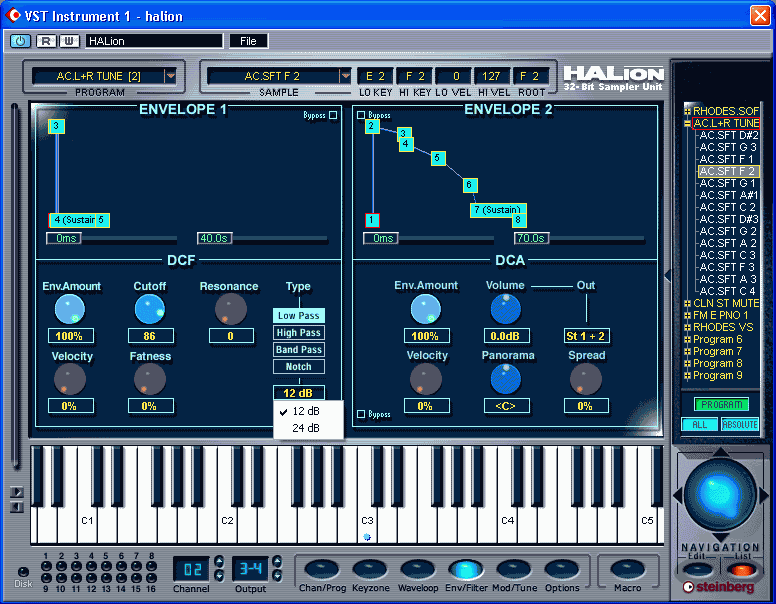 HALion sampler, Envelope/Filter view It makes possible to adjust certain parameters of each (!) sample separately. There are 4 standard filter types, like on the Macro tab, its envelope, sample's envelope and its main parameters. The next tab called Mod/Tune provides more regulators both for separate samples and for the whole instrument. 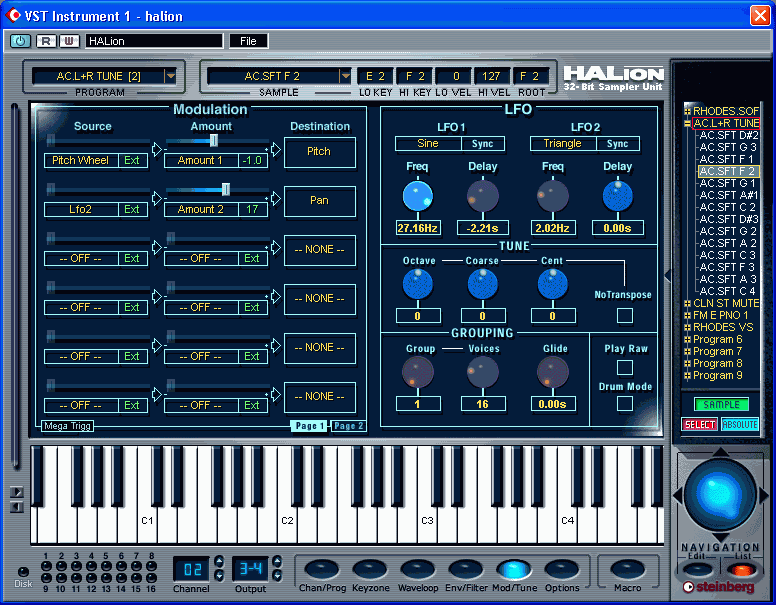 HALion sampler, Modulation/Tune tab This page is divided into two parts. The left one - Modulation - consists of three columns: Destination (where you can set an adjustable parameter), Amount (level) and Source. The right part, LFO, contains parameters similar to the Macro tab. The only difference is that you can edit both the whole instrument and a separate sample. The last tab is Options which houses several global settings. 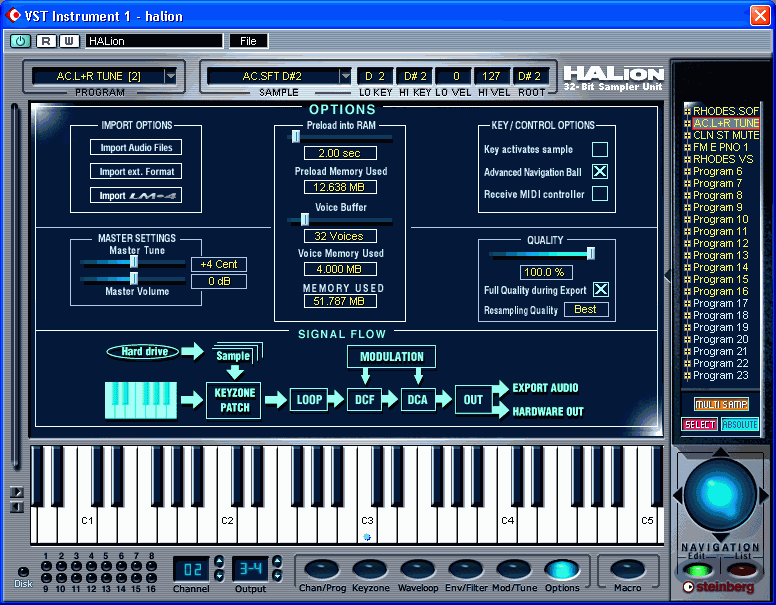 HALion sample, Options tab The Import Options item seems to be the most interesting here as it allows importing various compatible formats of samples. Click on the Import ext.Format and then Select a Device, and you will be carried into a small window. Here you can set one of four formats of imported samples. 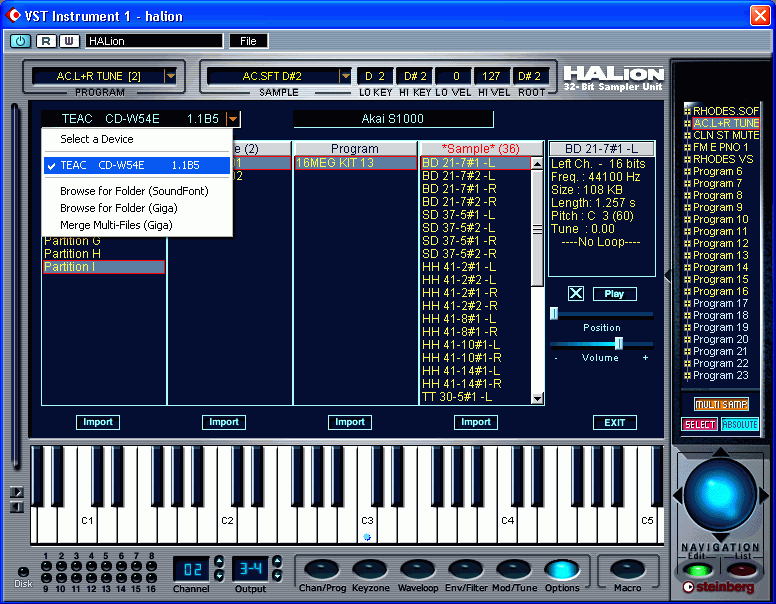 HALion sampler, Options view, import of samples from the CD in the AKAI format Insert a CD in the AKAI format into the CD drive and the sampler will detect and suggest importing any instrument (remember that AKAI discs have a file system incompatible with the Win32). Select the respective item and you will get into a very good sample browser where you can choose a sample or the whole partition to import into any folder which can be located in any place on the hard drive. It works the same way for audio files. You can previously listen them as well. 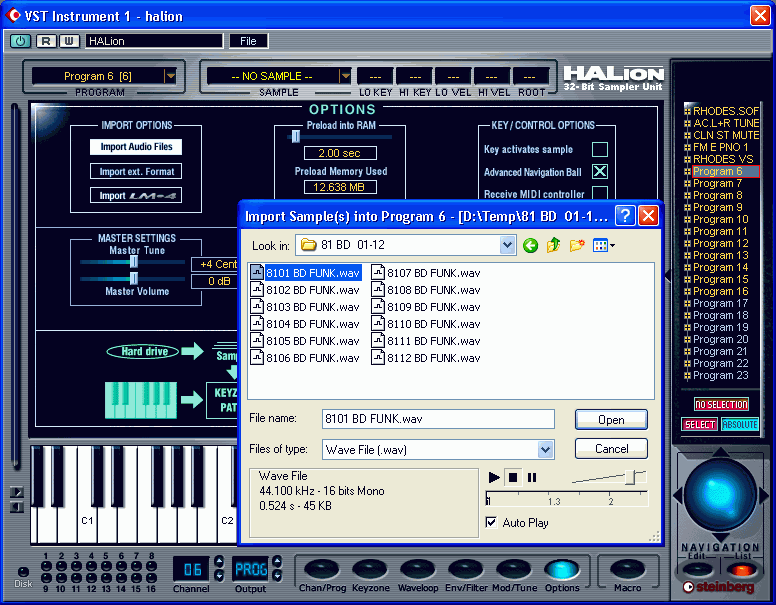 HALion sampler, Options view, importing of wave files In the Options tab you can set time and RAM size for preliminary loading of samples depending on power of your computer. ImpressionsBeside a higher level of music composing the HALion sampler makes this procedure much simpler. If earlier the only thought that I had to use the Gigastudio (because of higher-quality samples) depressed me, now we can forget about it. At first it seems a little awkward to work with the HALion. But a couple of hours later you get used to it. We suggest that you listen to the composition we wrote using two HALion samplers loaded into the Cubase SX. Flute Drawing 192 Kbit/s, 16 bit, 44100 kHz, stereo, 3.6 Mbyte. We used the Cubase SX sequencer as we consider it the most powerful application for today. Ready loops weren't involved; everything was done manually with a mouse and a MIDI keyboard including the part of drums. ConclusionThe HALion lets us create compositions of fine quality saving our precious time and releasing us from problems of compatibility of the Cubase and its VST plugins and the Gigastudio which needs a separate GSIF compatible device. Working with samples is not so boring and difficult any more. The design of the sampler is user-friendly and comprehensible and doesn't complicate our work at all. The HALion sampler might not meet all the requirements, but compared to its competitors this program is tenfold ahead. If you compose music but haven't used this godsend before, I recommend you try it. And remember that it's better to start with reading the manual. The HALion is not the thing that can be mastered using the try-and-error method. Finally, high-quality sound won't do wonder alone; your precious creative ideas are the diamond to be faceted. Write a comment below. No registration needed!
|
Platform · Video · Multimedia · Mobile · Other || About us & Privacy policy · Twitter · Facebook Copyright © Byrds Research & Publishing, Ltd., 1997–2011. All rights reserved. |